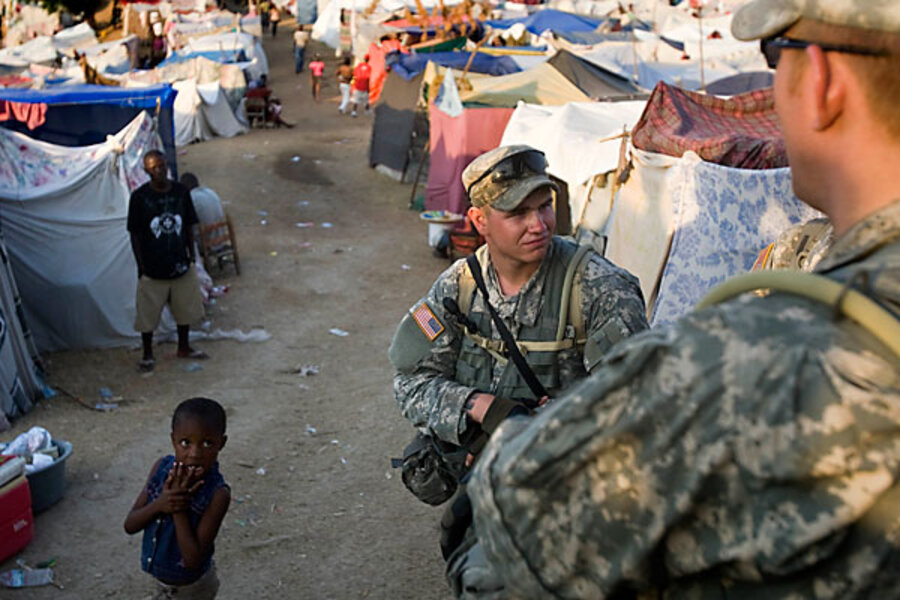After Haiti earthquake, US kids launch their own aid efforts
When Hannah Lucas first saw images from Haiti after the earthquake hit, she sobbed.
Then, the 8-year-old said, “Mommy, we need to do something. I need to do something,” remembers her mother, Robin Lucas.
Americans have responded faster to the disaster in Haiti than they have to previous crises, and many of those contributing – by launching fundraisers, holding bake sales, or emptying their own piggy banks – are children.
And, like Hannah, some are learning that helping can also help them feel less powerless in the face of such devastation.
“Kids are hearing that something is going on, that there is a problem somewhere, and kids can start feeling very helpless, particularly young children,” says Cynthia Langtiw, a psychotherapist at the Chicago School of Professional Psychology who specializes in issues of children and trauma. “Even just to give a quarter at school or to find a pair of socks they want to donate can be so empowering.”
For Hannah, the images on the news were overwhelming, and Ms. Lucas says she at first felt guilty for turning it on. But together they found a nonprofit, Partners in Health, that was seeking blanket donations, and Hannah decided to launch a blanket drive with a goal of 10,000 blankets. Her mother helped her create a simple website, and now all the schools in her Georgia district are participating. The national Parent Teacher Association (PTA) has picked it up, and Hannah recently got an e-mail from 8-year-old twins in Texas who are starting their own blanket drive.
“It’s like a light bulb turned on for her,” Lucas says. Next year, the family may consider a trip to visit Haiti, which Hannah has also been asking for.
Hannah isn’t the only young child to reach a fairly large audience. Charlie Simpson, a 7-year-old London boy, has been making news for a bike ride that has raised more than $200,000 for UNICEF’s Haiti fund.
But far more common are the thousands of classrooms, sports teams, and community groups – often led by one or two kids – that are coming together and creatively pooling their resources:
• Caitlyn Sather, a fourth-grader in Marietta, Ga., encouraged her school to hold a pajama day, in which kids were allowed to wear pajamas if they donated at least $2. She also has started collecting shoes for the Soles4Souls drive.
• Kate Lyn Sutherland, a 15-year-old 4-H club member in California, organized a fundraiser that raised more than $1,000 for the Red Cross.
• Three 8-year-old friends in Milan, Mich. – Sophia Morelock, Emily Runkel, and Maxine Tewsley – held a yard sale and bottle drive, raising $191.11 for the Clinton Bush Haiti Fund.
• Max Mines, a 12-year-old boy in Philadelphia, is organizing kids to busk – play music on the street – during the second week in February and to donate their earnings to Doctors Without Borders.
“We’ve seen a lot of schools and youth organizations that are organizing event-driven fundraisers,” says Elle Russell, manager of community engagement for Save the Children. “We sent out an e-mail to schools that supported us during the tsunami and were overwhelmed with the response we got back from teachers.”
Often, say mental-health experts, disasters like the one in Haiti can have a powerful effect on children, particularly if they’re exposed to the numerous images on the news. They encourage parents to be careful about how much media exposure they allow their children to have. And they suggest that parents discuss the news with their kids, helping them to process it or filter it.
“Particularly in young children, they have a tough time differentiating between reality and fantasy,” notes Michele Borba, an educational psychologist and author of “The Big Book of Parenting Solutions.” They might see repeated images and think that earthquakes are continuing to occur, for instance.
But Dr. Borba, like Dr. Langtiw, says that one of the most effective ways to help children cope isn’t to tune the news out completely – especially since they’re likely to hear about it somehow – but rather to show them how they can help.
“The younger the child, the more concrete the action should be,” Borba says. “An actual lemonade stand, collect the money, put it in an envelope himself, address the envelope.” In addition to such activity helping children feel less powerless, notes Borba, “it’s a lifelong habit that you’re teaching.... They realize, ‘I may be little, but I really can make a difference.’ ”
• For stories, blogs, and updates on Haiti after the earthquake, go to the Monitor's Haiti topic page.
-----
Follow us on Twitter.





